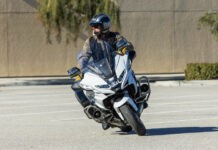
You know where you’re going and how you’re getting there. But what should you take, and how should you pack it? Here are some suggestions.
Don’t overpack. Wear the same clothes under your riding gear every day, and change into clean clothes at each nightly stop. Wear the riding clothes until you just can’t stand it, then swap them for your off-bike clothes and look for a laundromat. If you’re on a bike, and especially if you’re going to an event with a lot of other riders, nobody’s going to care if you wear the same T-shirt three days running. The general rule is to take half the clothes and twice the money you think you’ll need. If you need more clothes you can buy them on the road.

Center the load. Put heavy things down low in the front of the saddlebags to keep their weight close to the middle of the bike; heavy stuff up high, or too far rearward, can affect handling. Pack items you want to get at fast, like water, a rainsuit or heated gear on top, and put your tools and tire repair kit at the bottom. Pack a separate bag just for things that go into the motel room with you so you don’t spend 20 minutes rooting around in the saddlebags for your toothbrush.
Leave room. Changeable weather might see you starting the day’s ride bundled up against the cold and shucking out of it as the day warms. Do a trial pack by putting all your foul-weather gear in the saddlebags, then adding the rest of your luggage. That way you’ll always have room to stow your rainsuit, heated gear and thick gloves when the sun comes out.
Saddle up. Make sure you position luggage like soft saddlebags and tank bags so they don’t make it harder to get on or off the bike, or to plant your feet firmly at stops. Expandable tank bags are great until you fill them with so much stuff they block your view of the instruments. The same goes for expandable saddlebags, which, when heavily loaded, can droop enough to scrape in corners, or contact the exhaust or chain.
Do a trial run. Pack your bike and then go for a ride to see if the luggage straps come loose or rub on the paint. Take your foul-weather gear out and then put it back; if it takes more than a few minutes, rethink how you’ve packed it. Do some braking drills to see how the extra weight affects your stopping distance, and familiarize yourself with the handling under different circumstances. If you’re bringing a passenger, both of you and all your luggage should go on the dry run.
Just in case. If it turns out your luggage isn’t waterproof like the ad says, bring a couple of trash bags to put your gear in to keep it dry in the saddlebags. An extra bungee net is a good idea, too, in case that souvenir Mount Rushmore replica proves irresistible.












Good advice. I had hard bags and stuff on the seat and needed to send stuff home twice on the trip to Alaska. What feels ok on domestic interstates sometimes is not so good on Hwy 1 in Canada. I found the Motorcycle shops in Canada and Alaska more than happy to assist on equipment I forgot or needed repaired and most of what I carried for repairing (tools and parts) I never used or needed.
At Alaska Leather in Anchorage I was able to get a new FirstGear jacket at internet prices and they wanted me to take it for a test drive before I paid for it to make sure I liked it. When I replaced my rear tire in WhiteHorse they apologized for making me wait 30 minutes and was less than $30.00 more then my dealer in San Antonio Tx. charged me and I brought the old tire-rim off the bike to them to replace. I agree take a little more money and less gear.